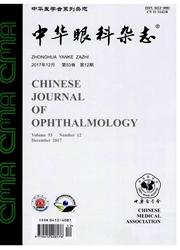

 中文摘要:
中文摘要:
目的分析透明角膜切口超声乳化白内障吸除术后急性细菌性眼内炎的临床特点和治疗效果。方法回顾性系列病例研究。收集青岛眼科医院2006年1月至2013年12月透明角膜切口超声乳化白内障吸除术后发生急性细菌性眼内炎患者的临床资料,分析该并发症的发生率、发生时间和临床特点、分泌物培养结果、治疗方式及预后情况。发病率的比较采用Fisher精确概率检验。结果8年间共行透明角膜切口超声乳化白内障吸除术16172例,发生急性细菌性眼内炎的患者21例(0.13%)。白内障手术和发生眼内炎的间隔时间中位数为6(1~37)d,其中57.1%(12/21)发生在1周以内。夏季发生率(0.25%,8/3169)略高于其他季节(F-8.61,P=0.05)。糖尿病患者发生率0.06%(3/4664),非糖尿病患者发生率0.16%(F=1.51,P=0.23);晶状体后囊膜破裂并行前节玻璃体切除患者发生率0.24%(1/416),无并发症患者发生率0.13%(F=0.00,P=0.42)。房水培养阳性率为33.3%(6/18),玻璃体培养阳性率为16.7%(1/6)。其中金黄色葡萄球菌2例,少动假单胞菌、干燥棒状杆菌、黏液奈瑟菌和粪肠球菌各1例。单纯药物治愈3例(14.3%);抗生素前房灌洗治愈8例(38.1%);抗生素前房灌洗联合玻璃体腔注药治愈6例(28.6%);玻璃体手术治愈4例(19.0%)。视力0.5以上16例(76.2%),0.1-0.4有5例(23.8%),无眼球摘除者。结论透明角膜切口超声乳化白内障吸除术后急性眼内炎多发生于术后1周内,本研究区域内夏季发生率略高于其他季节;通过早发现、分阶段、规范化的治疗可以获得较好的预后效果。
 英文摘要:
英文摘要:
Objective To evaluate the incidence of acute-onset endophthalmitis after clear corneal phacoemulsification and to report its clinical features, microbiology, and therapeutic efficacy. Methods It was a retrospective case series study. Medical records were reviewed for all patients diagnosed with acute- onset postoperative endophthalmitis from 2006 through 2013 associated with cataract surgery at Shandong Eye Institute of China. Results The 8-year frequency of acute-onset endophthalmitis after clear corneal phacoemulsification was 0.13%. The mean time between cataract extraction and endophthalmitis onset was 6 days (median, range 1 to 37 days). Endophthalmitis onset occurred within 7 days in 57.1%. The incidence was significantly higher in summer (0.25%) than in other seasons seasons (F=8.61, P=0.05). The incidence in diabetes was 0.06%, and in non-diabetic patients was 0.16% (F=l.51, P=0.23). There were no significantly difference (F=0.003, P=0.422, )in the endophthalmitis rates between those with capsular rupture (0.24%)and those without (0.13%). Three of the 21 cases (14.3%) were cured by antibiotic agents only. Antibiotic irrigation of the capsular bag was taken in 8 patients (38.1%). Six patients (28.6%) had both antibiotic irrigation of the capsular bag and intravitreal injection of the antibiotics and the other 4 patients (19.0%) were cured by vitreous surgery. Cultures were positive in 33.3% of cases with aqueous humor samples and in 16.7% of cases with vitreous biopsy. The culture isolates showed Staphylococcus species in 2 eyes, while Pseudomonas paueimobilis, Corynebaeterium xerose, Neisseria mueosa and Enterococcus faecalis in 1 eye respectively. Sixteen patients (76.2%) achieved a final visual acuity of 20/40 or better. Five (23.8%) had worse than 20/40 to better than 20/200. No eyes were eviscerated. Conclusion Early recognition and appropriate treatment are the most important factors in the successful management of endophthalmitis.
 同期刊论文项目
同期刊论文项目
 同项目期刊论文
同项目期刊论文
 期刊信息
期刊信息
